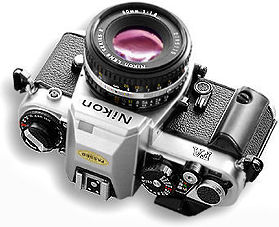 |
The Nikon FA is an automatic camera. It needs a power source to function. (Except a few controls that work mechanically). To begin with this section, first - turn the shutter speed ring to either a numeral 'M250' or 'B'. Why are these two settings operational even without battery? Good question, just remember your first experience with Nikon FA. Should one day the camera 'malfunction' - the most likely cause could be relates to power issue. That two settings will work even if you don't have any power cells installed in your camera - that could be a life saver feature. Just in case. |
These sections are created for any new Nikon FA camera owner. I have always thought most new user don't care much about understanding their equipment first before start using their hardware. I know it can be every exciting to have a new camera body, but if you have loaded an unexposed film roll inside the camera, how can you get a real feel of it ? In the long run, this could restrict you in creatively apply the basic features in a camera provided, understand the alternative means and available options to tackle difficult tasks that could arise at times on the field.
I don't like to use the form of a camera manual to start off. But as I said earlier, I had prepared these for any potential FA owners or those who may have lost, mis-placed or don't undertand what the content in the manual are all about, I will try to explain here and add other helpful info that may help you undertand this camera better. Hopefully you can explore more with what this camera can offer you in whatever application later on your own.
The Nikon FA needs
battery(ies) to power majority of its operations like metering, shutter
mechanism etc. Just turn your camera upside down, then you will see the
battery compartment just next to the tripod socket. Use a coin to unscrew the
battery clip lid in a counterclockwise direction and it will open. First there
is a very high possibility that when you got your camera back, the shop
assistant could have installed the battery for you. Thus, this section is just
meant for future reference.
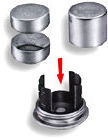 |
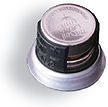 |
What kind of batteries does the FA takes ? Simple. It can take either two (1.55V) S-76 Silver Oxide, or two (1.5V) LR44 (Alkaline-manganese type) or one 3V CR 1/3N Lithium power cell (s). A fresh installation can last for about a year, depends on uasge. |
Make sure the battery
contacts are clean. As most problems arise from automatic cameras are battery
related. Sometimes, even an invisible film from your oily finger tips may
prevent proper contact. Generally, as for normal guideline in camera care,
never hold any cells in the center, only at the side. You may use either a
clean cloth to clean off a light layer of oxidation, and a pencil eraser from
your child's pencil box will remove heavier deposits that may deposited at the
cells' polarity surfaces. Make sure you also clean the contact points (battery
clip) inside the camera battery compartment. After correct installation,
insert the holder back into the battery chamber using a coin to screw it
securely into place and your camera will be ready to function. If it doesn't,
open and double check the polarity marks on the cells.
The Nikon FA, as
with any of the automatic manual focus Nikon bodies like the FE or FE2 has
some accessory for you to work in extreme of temperature. The Anti-Cold
Battery Pack DB-2 is one of such device. In cold weather, you can
use the Anti-Cold Battery Pack DB-2, which accepts two AA-type batteries, as
an alternative power supply to the batteries inside the camera body. Simply
connect the DB-2 to the camera body, then slip the assembly inside your pocket
or coat to keep it warm. This assures that the camera's metering system will
function even in very cold temperature.
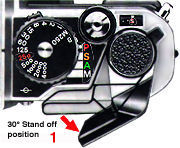 |
How to check if the battery is correctly installed ? First, just pull the film advance lever out to its 30° "stand-off" position (1). Why? Because, the film advance lever acts also as the on/off switch. |
If the film advance lever is flush with the body, the power to the camea is off and you can not activate the meter by half-depressing on the shutter release button. This was designed to act as a safety lock for accidental tripping of the shutter release if the camera is not used.
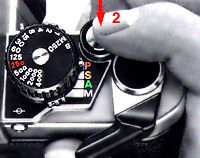 |
When you depress the shutter release button halfway (2), the exposure meter will react, a numeral will appear in the the liquid crystal display (LCD) at the upper left-hand portion of the viewfinder (3). |
When a numeral appears on the LCD , this indicates that battery installation is correct and power is sufficient. If the LCD does not appear, recheck battery orientation or, if necessary, replace with a new set. With sufficient battery power, the LCD stays on for 16 sec after you take your finger off the button.
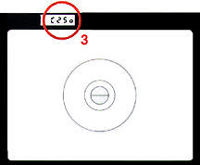 |
If the batteries are weak, the LCD will turn off immediately when you take your finger off the button. In this case, replace batteries as soon as possible. With exhausted batteries, you cannot trip the shutter unless the shutter speed dial is set at a mechanical setting of M250 or B. |
* Note: If you have spotted any other
display other than the one mentioned here, always referred to LCD Readout Section compiled in this site for cross
reference.
In any case, the LCD does not appear when the shutter dial is set at M250 or B because M250 and B are not in any way connected to the power supply and they are battery independent, battery testing cannot be performed either of these two speeds.
Some issues relate to batteries for camera.
|
1. |
When the batteries are drained, or there are none installed in the camera, or if it fails to function normally due to extreme change in temperature, the only two settings which can be used are ìM250î and ìB.î If you trip the shutter with the camera set to any other speed, the shutter wonít open or the reflex mirror may remain in the ìupî position. If the mirror locks up, simply turn the shutter speed dial to ìM250î and the mirror will return to its normal viewing position. Then you can install new batteries (In case cold weather is the cause, use a anti-cold battery holder pack DB-2 to replace the cells). To avoid wasting a frame, stroke the winding lever while holding in the multiple-exposure lever. |
|
2 |
Should the battery be left in the battery chamber for a long period, insufficient contact may occur due to battery leakage. Thus, it is good practice to periodically clean the battery and the contact section in the battery chamber with a soft cloth. If the battery chamber is contaminated with a leaking battery, remove the battery at once and clean the chamber. Before doing so, try to clean and removed any deposits remains inside, esp the clips housed inside the compartment and do a few test shots, but I would strongly suggest you to send for examination of the damage done. |
|
3 |
For safety reasons at home. After removal of the cells, remember to keep them away from children. Never attempt to throw them to fire place, it may explode. In any case, the camera is not the cause for any mishap - only the carelessness of its owner. |
|
4 |
Battery power falls off in extremely cold temperatures and this may cause the camera's photometric circuit to cease operating. In this situation, use new batteries~and protect the camera body from the cold. Note that battery power will be recovered as soon as the temperature becomes normal. Nikon has a anti-cold battery holder pack DB-2 for this purpose. |
|
5 |
Regardless of whether the camera is switched off or not, the FA always discharges a small amount of electricity because it incorporates a quartz oscillator circuit. |
| Back | Next | 1/13 parts